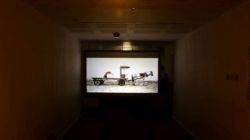
Hilla Ben Ari / Amalia Kahana-Carmon
Hilla Ben Ari
Born on Kibbutz Yagur, 1972
Lives and works in Tel Aviv
Hilla Ben Ari's tribute to Amalia Kahana-Carmon's stories relates to the recurrent motif of the journey - which does not lead to an experience of freedom, but rather underscores the limitations and vulnerability of the female body. In recent years, Ben Ari's video works have focused on images of female figures in challenging poses: standing with one leg on a beam; raising one leg up in the air, or (as is the case here) - stretching into a bridge position. Ben Ari's camera is static, so that the image itself seems frozen until one notices the slight movements caused by breathing or physical exertion. When she filmed the figure in the bridge position on a horse-drawn carriage, Ben Ari thought of the female figures in Kahana-Carmon's stories who travel on buses, in carriages, or on planes - usually accompanied by men who take them or deliver them to various places. In the video work The Mute, every component of the picture - including the horse, the immobile carriage, the absent driver, and, of course, the female figure - is suspended between movement and stasis, resistance and submission.
Amalia Kahana-Carmon
Born on Kibbutz Ein Harod, 1926
Lives in Tel Aviv
The writing of Amalia Kahana-Carmon, a recipient of the Israel Prize for Literature (2000), centers on female experiences of emotional, economic, and physical vulnerability. The characters in her stories often suffer violence that is not necessarily visible, and which is gradually exposed in the context of their relations with men and of the larger social order. Kahana-Carmon defines herself as a woman writer, and underscores the difference between male and female modes of writing, arguing that the female experience has been marginalized in Israeli literature due to the dominance of the male model.